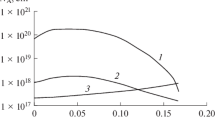Abstract
The energy consumed by electron devices such as field-effect-transistors (FET) in an integrated circuit is mostly used to process different electrical signals. However, a fraction of that energy is also converted into heat that gets transferred throughout the integrated circuit and modifies the local temperature. The modification of the local temperature, which is interpreted as a self-heating mechanism, is a function of different charge carrier scattering mechanisms, the characteristic energy relaxation times for charge carriers, the heat carrier mechanisms, the geometry of the FET, the volume of the integrated circuit, and the composed thermal properties of the integrated circuit and the system package. Besides all those dependencies, the charge and heat transport properties are temperature dependent. All these features make the electrothermodynamic analysis and modeling of low-power cryogenic electron devices a compulsory need. In this work, we introduce an analysis based on experimental results obtained from characterizing FET test structures in the temperature range between 300 K and down to 3.1 K.









Similar content being viewed by others
References
D. Loss, P. DiVincenzo, Phys. Rev. A 57, 120 (1997). https://doi.org/10.1103/PhysRevA.57.120
F.F. Fang, A.B. Fowler, Transport properties of electrons in inverted silicon surface. Phys. Rev. 169(3), 619–631 (1968)
K. Masaki, K. Taniguchi, C. Hamaguchi, Electron mobility in Si inversion layers. Semicond. Sci. Technol. 7, 573–575 (1992)
E.A. Gutiérrez-D, M.J. Deen, C.L. Claeys, Low Temperature Electronics, Physics, Devices, Circuits, and Applications (Academic Press, Cambridge, 2001), pp. 26–36
G.A. Rodriguez-R, E.A. Gutierrez-D et al., Thermo-magnetic effects in nano-scaled Mosfet: an experimental, modeling, and simulation approach. IEEE J. Electron. Dev. Soc. 3(2), 78–84 (2015). https://doi.org/10.1109/jeds.2015.2390629
M. Kim, Y. Jeon, Y. Kim, IEEE Trans. Nanotech. 14, 633–637 (2015). https://doi.org/10.1109/TNANO.2015.2427453
K. Raleva, D. Vasileska, A. Hossain et al., J. Comput. Electron. 11, 106 (2012). https://doi.org/10.1007/s10825-012-0384-0
J. Roig, E. Stefanov, F. Morancho, IEEE Trans. Electron. Dev. (2006). https://doi.org/10.1109/ted.2006.876277
Acknowledgements
We acknowledge CONACYT for supporting grants for Ph.D. studies.
Author information
Authors and Affiliations
Corresponding author
Additional information
Publisher's Note
Springer Nature remains neutral with regard to jurisdictional claims in published maps and institutional affiliations.
Rights and permissions
About this article
Cite this article
López-López, O., Martínez, I., Cabrera, A. et al. Energy Consumption, Conversion, and Transfer in Nanometric Field-Effect Transistors (FET) Used in Readout Electronics at Cryogenic Temperatures. J Low Temp Phys 199, 171–181 (2020). https://doi.org/10.1007/s10909-020-02340-6
Received:
Accepted:
Published:
Issue Date:
DOI: https://doi.org/10.1007/s10909-020-02340-6




